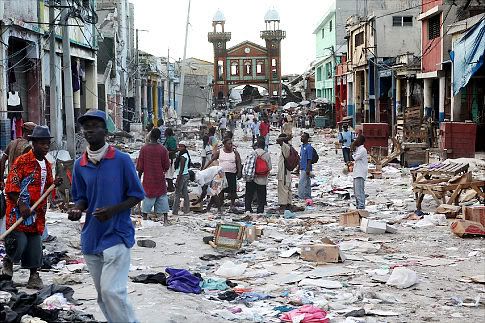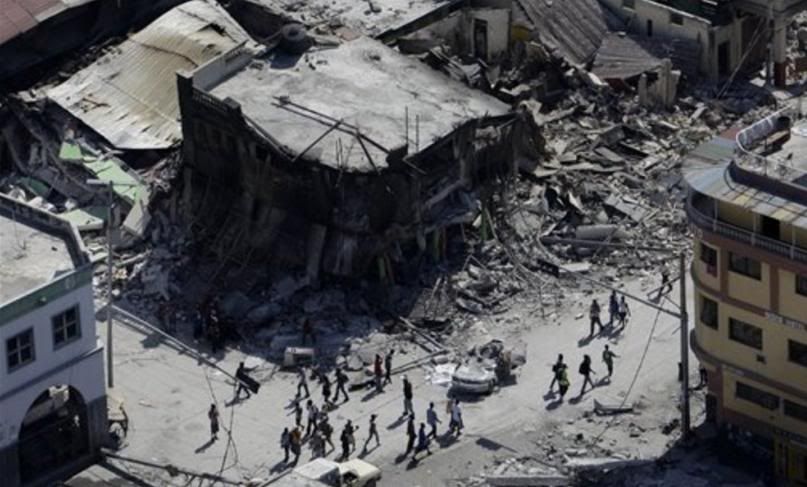Earthquake in Haiti: Marines head to Haiti to control angry looters on disaster-ravaged island
BY BRIAN KATES AND CORKY SIEMASZKO
DAILY NEWS STAFF WRITERS
Originally Published:Friday, January 15th 2010, 10:48 AM
Updated: Friday, January 15th 2010, 1:03 PM
As aid begins to pour in to Haiti, experts are stressing the importance of coordination between a weak central government, a constellation of non-governmental groups and international governments.
Send in the Marines! Six years after the U.S. dispatched the fighting force to Haiti to prevent a civil war, the Leathernecks are heading back Monday to keep anarchy from breaking out in the earthquake-ravaged country. And not a moment too soon. The United Nations reported that its warehouses in the Haitian capital of Port-au-Prince had been looted and it didn't know how much of its pre-quake stockpile of 15,000 tons of food aid remained. Haitian police "are not visible at all," because many fled their posts after the quake hit Tuesday, UN officials said.
"We are worried about security," Brazilian Defense Minister Nelson Jobim warned Friday after visiting the shattered capital.
"As long as the people are hungry and thirsty, as long as we haven't fixed the problem of shelter, we run the risk of riots." 
People walking among damaged buildings in Port-au-Prince, Friday, Jan. 15, 2010.
The Marines will be reinforcing 300 troops from the U.S. 82nd Airborne Division already on the ground and other soldiers aboard the aircraft carrier USS Carl Vinson, Lt. Gen. Ken Keen told ABC's "Good Morning America."
"We have much more support on the way," he said. "Our priority is getting relief out to the needy people."
By Monday, there should be 5,500 U.S. soldiers and Marines in Haiti providing security, White House spokesman Robert Gibbs said. The Marines were last sent to Haiti in 2004 to restore order after the government of Jean-Bertrand Aristide was toppled. Before that, the Marines were dispatched several times to protect American interests in the turbulent country. Their 19-year occupation of the country, which ended in 1934, was deeply resented by many Haitians. 
Men dig by hand trying to reach people they believe are still alive trapped in the rubble of a collapsed building in Port-au-Prince, Friday, Jan. 15, 2010.
Cuba gave the U.S. government permission to fly desperately-needed aid through their air space. That deal, which pushes aside decades of Cold War animosity between Washington and Havana, will cut a precious 90 minutes off the one-way flight from Guantanamo to Haiti. It is also expected to help open the logistical bottlenecks at the damaged Port-au-Prince airport which has caused Haitians to receive just a trickle of aid four days after the quake. "I don't think that a word has been invented for what is happening in Haiti," said Liony Batista, the Food For the Poor project manager in Port-au-Prince. "It is total disaster."
The UN reported that an estimated 300,000 people have been left homeless and one in 10 homes in the capital were destroyed. Getting around Haiti (a desperately poor country with shoddy roads) has always been hard, and the damage done by the quake has made getting aid to the survivors (many living in the streets) even harder.
"The physical destruction is so great that physically getting from point A to B with the supplies is not an easy task," World Food Program spokeswoman Emelia Casella said. The WFP, which began organizing distribution centers for food and water on Thursday, was preparing shipments of enough ready-to-eat meals to feed 2 million Haitians for a month.
Also en route (from more than 20 countries around the world) were planeloads of high-energy biscuits and other food, tons of water, tents, blankets, water-purification gear, heavy equipment for removing debris, helicopters and other transport. More than $400 million in aid has been pledged to Haiti, a fourth of that from the U.S. The Red Cross estimates 45,000 to 50,000 people were killed. The toll could go much higher as the spectre of infectious disease spreads. Hundreds of bodies remained stacked outside the overflowing Port-au-Prince morgue. Limbs of the dead protruded from the rubble of crushed schools and homes. There were still reports of rescuers freeing people who had been trapped under the rubble for days. But a more common sight was of bulldozers carrying corpses to a mass grave.
Haitian President Rene Preval told The Miami Herald that over a 20-hour period government crews had removed 7,000 corpses from the streets. But countless bodies remain unburied - and unclaimed. Outside a pharmacy, a dead woman lay covered by a sheet, her tiny foot poking out from under the covering.
Read more:
http://www.nydailynews.com/news/world/2010/01/15/2010-01-15_earthquake_in_haiti_as_desperate_victims.html#ixzz0chvGqvp5
This half-meter resolution satellite image shows Port-au-Prince, Haiti after a 7.0-magnitude earthquake struck the area on Jan. 12, 2010. The image clearly shows extensive damage, roads covered with debris from collapsed structures, and people crowded in the streets and public places such as sports fields and stadiums. The white-colored National Palace shows damage along the roof line. The image was taken by the GeoEye-1 satellite from 423 miles in space at 10:27 a.m. EST on Jan. 13, 2010 as it moved from north to south over the Caribbean at a speed of four miles per second.

The Red Cross has stated that as many as 3 million Haitians have been affected by the earthquake, with as many as 100,000 deaths likely, according to Haiti's prime minister. Since the quake's epicenter was right off the capital city, Port-au-Prince, most of the official buildings, from government officials' residences to jails and hospitals, have been significantly damaged or completely leveled.
Friday, January 15, 2010
Haiti Earthquake: The Aftermath
Subscribe to:
Post Comments (Atom)
0 comments:
Post a Comment